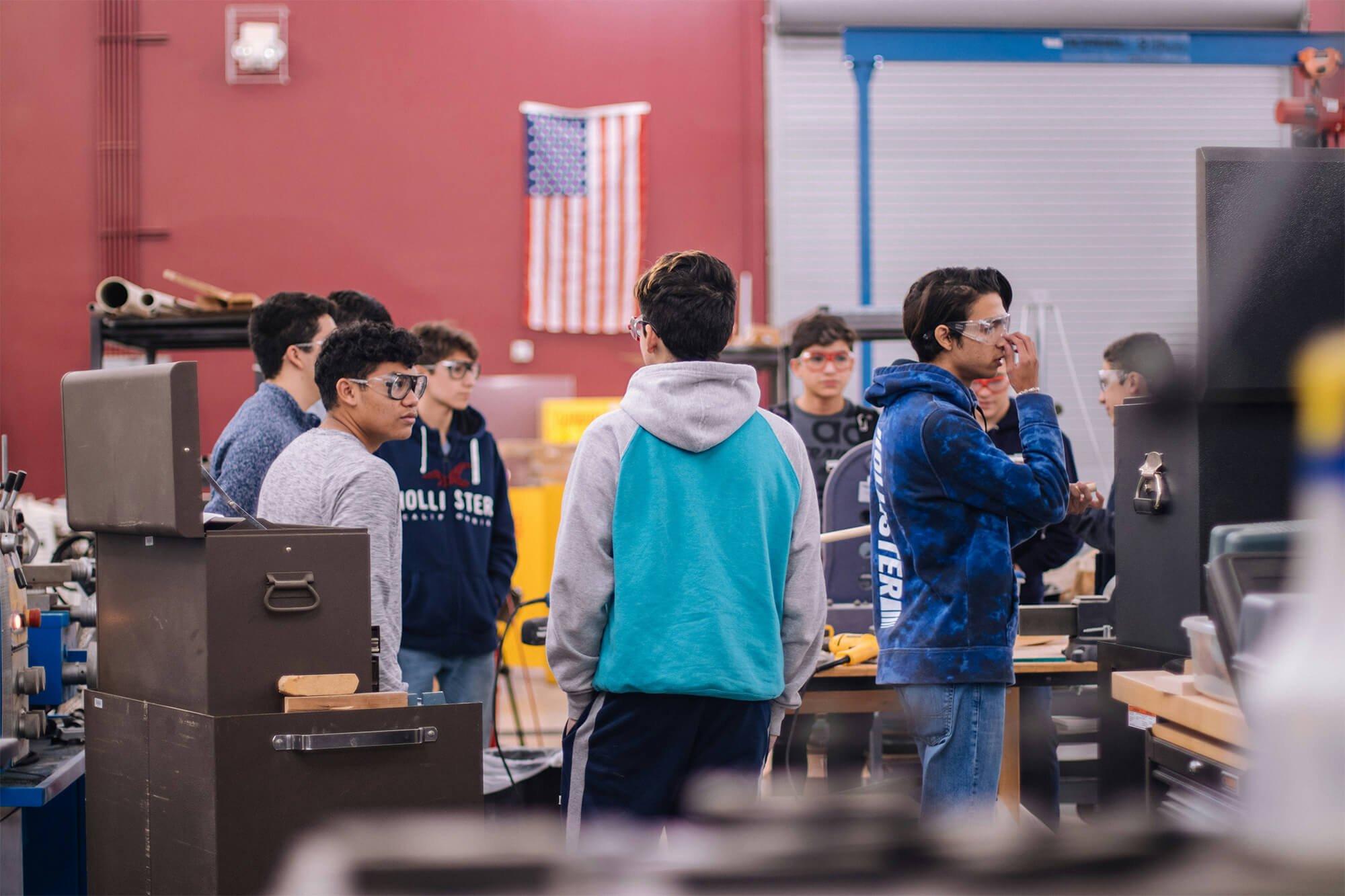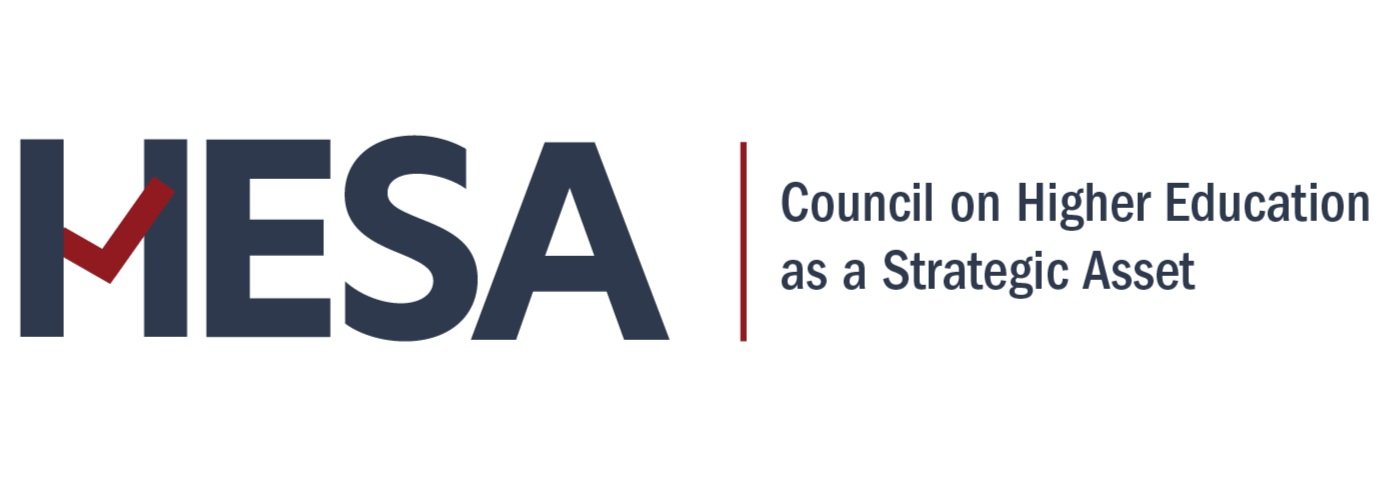
Higher Education is Foundational to Our Country’s Prosperity, Competitiveness, and Security
Higher education is a critical strategic asset of the United States of America. Our country’s commitment to increasing access to education coupled with our entrepreneurial spirit are among our country’s greatest strengths and are drivers of our economic prosperity and national security. College graduates are powering our existing businesses and inventing new ones. They are contributing to the vibrancy of our communities, working to solve the challenges facing our society, and leading our social organizations and democratic institutions.
Globally, American higher education continues to lead the way. The United States boasts 13 of the top 20 universities in the world.
The U.S. remains the top destination for international study, with nearly 1 million students coming from other countries to enroll at our colleges and universities.
Our universities and colleges are stronger because they are globally connected, because they attract students from around the world, and because they offer opportunities for students to travel and learn in other countries. This is key to our power internationally and to our national security and expertise. It also ensures that we are building future generations who demonstrate openness to different perspectives and understanding of how this country can have greatest impact and success worldwide. Our ability to attract the best and brightest from around the world to study at our institutions is a critical part of our country’s overall talent strategy and those that remain contribute substantially to the U.S. economy.
The United States once led the world in educational attainment, and it was the gap between us and the rest of the world that fueled our prosperity. But current trends indicate that this advantage is fading with potential dire consequences for the strength of our economy and military and our global leadership position. Several factors are challenging our ability to maintain this strategic advantage.
The emergence of artificial intelligence and advanced technologies, growing workforce gaps, strategic educational investments by other countries, and the changing needs of learners are combining to create a growing misalignment between the current approaches to the design and delivery of education and the changing needs of our society.

Our Technologically Advanced Society Needs Talent to Thrive
Technological advances, such as artificial intelligence, quantum computing, and bioengineering are transforming our world.
They are disrupting our workplaces and causing major shifts in the types of skills individuals will need to lead flourishing lives, to remain productively engaged in the U.S. economy, and fill the jobs our employers require. It is estimated that job growth from digital technologies will be positive over the next five years, but the churn will be nearly 25%. The ability to adapt will be paramount.
Jobs in the future will demand more advanced skills and increasing levels of education.
By 2031, 72% of
jobs in the U.S.
will require postsecondary education or training.
A deeper look at the overall workforce shortages within the U.S. reveals troubling gaps in several key industries.
Healthcare Sector: The healthcare industry has been particularly affected by workforce shortages, especially in nursing and allied health professions. The U.S. Bureau of Labor Statistics reports the demand for registered nurses is projected to grow by 6% from 2023 to 2033, translating to approximately 194,500 job openings annually. Factors contributing to this gap include an aging population, increased healthcare demands, and high burnout rates exacerbated by the pandemic. Closing this gap would require doubling the number of new graduates entering the nursing workforce every year for the next three years.
Artificial Intelligence and Cybersecurity: The technology sector is experiencing a significant talent shortage, particularly in areas such as cybersecurity, data analysis, and software development. A report by ISC2 reports a shortage of over 500,000 cybersecurity professionals in the U.S. Overall employment in computer and information technology occupations is projected to grow from 2023 to 2033, with 356,000 openings projected each year. Technology skills gaps are impacting every technical field including cybersecurity, software, data, infrastructure, and IT support. The rapid pace of technological change and the need for continuous skill upgrading contributes to these gaps. There are specific concerns about the availability of digital talent in the Department of Defense and the Intelligence Community, with calls for the creation of new talent pipelines to train current and future employees to be AI-ready by 2025.
Education Sector: The education sector, particularly K-12 schools, is grappling with declining educational outcomes and teacher shortages in various subjects, including math, science, and special education. While severity varies by state and area, it is estimated that the U.S. had approximately 400,000 unfilled or underfilled teacher positions in 2024. Factors such as low salaries, high workloads, and challenging working conditions have made it difficult to attract and retain qualified educators, which is hampering our ability to make progress on high quality learning. We need new approaches to developing well-qualified K-12 educators and new models for K-12 schools to produce high school graduates prepared to succeed in postsecondary education and careers post-graduation.
Engineering Sector: The U.S. will need about 400,000 new engineers every year, especially in areas such as software, industrial, civil, and electrical engineering. Current patterns of education and skills development are not keeping pace and could lead to nearly one in three engineering roles unfilled through 2030. The need for engineers is being driven in part by major federal efforts to advance American infrastructure and security. The recent $3 trillion investment in critical infrastructure and technology, including the American Rescue Plan Act, the Infrastructure Investment and Jobs Act, the Inflation Reduction Act, and the CHIPS and Science Act will create millions of new jobs, many requiring engineering talent.
These growing skills gaps and unfilled positions in key industries has the potential to negatively impact the U.S. and global economies. As the demand for skilled workers outstrips supply, the resulting talent shortage could result in $1.75 trillion in unrealized economic activity. These gaps are a result of an aging population, declining labor force participation, and a mismatch between skill levels of individuals and those required in high demand fields. By 2030, the U.S. will have an overall surplus of mid-skilled and low-skilled workers but an undersupply of high skilled workers of nearly 6.5 million.
These talent gaps are significant, and if not addressed, will have detrimental impact on America’s global competitiveness and national security, and yet we currently have no national strategy to develop the necessary talent pipeline to fill those jobs.

Our Country Cannot Afford the Luxury of Wasted Talent
Complicating the picture are the demographic and geographic shifts that are occurring in our country.
The number of students attending a college or university full-time, straight out of high school, is getting smaller. The decline in births caused by the 2008 recession will be in full force across many areas of the country by 2025, and the declines in traditional student enrollment in college are expected to continue through the mid-2030s. The number of students earning college degrees fell for two consecutive years. Almost 100,000 fewer people earned bachelor’s and associate degrees or certificates during the 2022–23 academic year, a 2.8% decrease.
The U.S. population is becoming more urban. The percentage of individuals living in urban areas rose from 70% of the population in 1960 to 83% in 2022. At the same time, economic and job growth is occurring predominantly in urban areas. By contrast, 54 cities and roughly 2,000 rural counties, collectively home to 78 million people, have older and shrinking workforces, higher unemployment, and lower educational attainment. In a growing digital economy, education and reskilling will be a key to harnessing talent and providing employment opportunities for these rural populations.
Even as the number of traditional students declines, the demand for education is expected to grow in other segments, especially adult learners. In addition, there are significant gaps in degree attainment that point to the barriers faced by students from rural communities, low- and moderate-income households, and from a wide range of diverse racial and ethnic backgrounds.
Black and Native American students have bachelor’s completion rates more than 20 points lower than White students.
Bachelor's degree attainment rates are almost 4 times higher for students in the highest income quartile than those in the lowest.
25% of adults aged 25-34 who live in rural areas have earned a bachelor’s degree compared to 44% of those who live in urban areas.
About 40% of students who enrolled in postsecondary education have not completed a postsecondary degree or certificate. The result is about 39 million individuals in America with some college but no degree, a category that is growing.
The current system is not working for too many hardworking Americans. Many are eager to contribute to our country’s economy but are held back by an educational system not designed to support their needs. Too many students enter their postsecondary education not prepared with the core skills and knowledge that are necessary to be successful in college. Too many leave without completing a credential in their chosen field of study. Too many forgo higher education entirely, viewing it as too expensive or not worth the investment. All Americans deserve access to the skills and training needed to secure higher-paying, family-supporting jobs.
This decreasing sense of value and return on investment is impacting our ability to develop the level of talent our country needs for the future. These attainment gaps also have economic consequences.
If our country achieved a comparable degree attainment rate across all segments of our population, our country’s workers would accrue an additional $11.3 trillion in net lifetime earnings.
The current system is not working for too many hardworking Americans. Many are eager to contribute to our country’s economy but are held back by an educational system not designed to support their needs

The World is Investing in Higher Education as a Strategic Asset
The same trends impacting America are being felt around the globe, and other countries have made increasing the education levels of their citizens a strategic focus.
The gap between the educational levels of the U.S. and the rest of the world was once our country’s competitive advantage. It is what has kept us safe and prosperous as a nation. But that gap has disappeared as other countries are putting into place the education models, policies, funding, and strategic goals that once firmly established America’s leadership position.
A look at postsecondary attainment rates around the world highlights the growing strategic focus. Recent data from the OECD reveal a growing divide between the U.S. attainment rates and those of other developed countries. The U.S. once led the world in educational attainment. Currently we rank 13th overall. At 54.3% of our population with a postsecondary credential, the U.S. lags well behind other developed countries, including South Korea (69.6%), Canada (64.4%), Russia (62.1%), Japan (61.5%), and Ireland (58.4%). The U.S. has made progress, moving from 44.3% to 54.3% of its population with a postsecondary degree or credential, but our rate of improvement has not kept pace with the rest of the world.
The types of skills gaps and labor shortages experienced in the U.S. are also global challenges. Developing nations are recognizing that improving their education systems is key to gaining global economic position. China has identified talent as the number one resource for meeting the strategic needs of their country. India has committed to “massification” of tertiary education and hundreds of new institutions have opened as part of its National Education Policy 2020. In addition to increasing overall attainment, countries are targeting specific fields as areas of strategic importance. One example is China’s focus on artificial intelligence. It is estimated that China is now the source for nearly half of the world’s top AI researchers, compared to 18% from the U.S. The good news is that after completing a PhD in the U.S., the vast majority of non-American AI talent stay and work in U.S.
Unlike other countries, the United States has no mechanism by which we identify and prioritize talent needs. There is growing interest from within and outside higher education to investigate new approaches to developing an integrated talent strategy and expanding education-workforce collaboration. The World Economic Forum’s Centre for the New Economy and Society recognized that existing education and learning systems played a critical role in expanding our economies and the middle class, but “they lack the features to achieve the scale and speed needed in the new world of work.” The need to bring together employers, federal and state governments, and higher education institutions to address critical workforce gaps and develop talent management strategies for the future is vital.
This strategic challenge of aligning critical talent shortages with the production of credentials in relevant fields remains a daunting hurdle for our nation. As other countries have done, including our greatest adversaries and competitors, the U.S. must identify, prioritize, and develop the talent needed to fuel our economic competitiveness and meet our national security needs.

Addressing Talent Needs Will Require New Models Built for Tomorrow’s Learners
As we move from a national, analog, industrial economy to a global, digital, knowledge economy, our country’s higher education institutions will be more essential than ever in producing, preserving, applying, and disseminating the knowledge necessary to thrive in a dynamic, technologically advanced society. But to do so, our country will need to reimagine our education models and policy frameworks to better serve a changing profile of learners and produce the outcomes necessary for our country to thrive in this new era.
Educational models will need to become more personalized and recognize learning that occurs inside and outside of a traditional academic setting and over a person’s entire life.
Learners are coming to higher education from different backgrounds and with different experiences, knowledge, and personal and professional goals. Traditional educational models are predominantly based on groups of students being exposed to the same material, regardless of their prior learning, and who progress through the material at the same pace, regardless of individual comprehension. Personalized learning models provide the opportunity to engage learners on their own terms and customize instruction in a way that responds to the specific learning needs of students. Delivering effective personalized learning models at scale will require the development of new approaches to pedagogy and faculty development, designs that retain opportunities for shared learning, and an investment in educational technologies that are affordable and available to all institutions.
Degrees and credentials should have multiple pathways to completion that more closely reflect the needs and experiences of different student segments.
Providing new pathways to degrees and credentials will be critical to addressing predicted workforce skills gaps. Today, less than half of college students live on campus, more than half are employed full- or part-time, 38% attend part-time, and 22% have children of their own.
And yet, much of our higher education delivery, policy, and funding models are still anchored to this traditional path to a degree.
To remain globally competitive, we must work across institutions and with employer partners to ensure pathways to high quality degrees and credentials are widely available, including improving credit mobility and developing common frameworks for alternative and non-credit credentials and certifications. Expanding the number and types of pathways would highlight the unique capacities of different types of institutions to deliver high-impact learning experiences customized to different student populations with different needs. Creating new pathways will require developing program designs and policy frameworks that link K-12, higher education leaders and faculty, and the employer community.
Learning experiences should emphasize the development of the essential skills and competencies that drive our creative, knowledge economy and cultivate informed citizens prepared to engage constructively in our democracy.
U.S. higher education’s unique combination of professional preparation and a broad education in the arts, humanities, and natural and social sciences, is lauded as the reason for our country’s ingenuity, innovation, and economic and civic impact.
The essential connection between the goals of a liberal arts education and specialized professional training were recognized 80 years ago by the Truman Commission and the combination is even more critical as a response to our complex, dynamic, and technologically advanced society.
Our educational system, including K-12 and higher education, must prepare our people to both thrive in the new realities being created by evolving technologies and to lead in a rapidly changing world. A future, uniquely American education would strengthen the capacity to solve existing problems and to imagine new possibilities by focusing on critical thinking, creativity, and resiliency. It would prepare people to harness and work alongside exiting and emerging technologies by focusing on digital and data literacies. And it would emphasize the skills and competencies that allow us to engage with each other as humans by focusing on communication, empathy, teamwork, and civic engagement. Fully integrating these human skills across a broad set of fields may require a reconceptualization of program design to include these essential, durable skills and the development of the next generation of faculty who are prepared to design and deliver a curriculum that better integrates these essential outcomes, regardless of academic program or credential.
The outcomes of educational experiences should be measurable and transparent to students, employers, and the public.
Relying on seat time, degrees, and institutional reputation to communicate the quality of learning will be insufficient in the knowledge economy. The shifting nature of work and the growing focus on skills and competencies points to the need to document and communicate what learners know and can do because of their education. Competencies, skills, and abilities will be the knowledge economy’s educational accounting system and advancements in research in cognitive and learning science hold the potential to facilitate this critical shift. Our current ability to measure and communicate learning is underdeveloped—a gap that must be addressed in the future. Creating multiple degree and credential pathways and advancing personalized learning will require more effective, common ways to measure competency, with the definitions being transparent and understood by employers, institutions, and learners alike.


